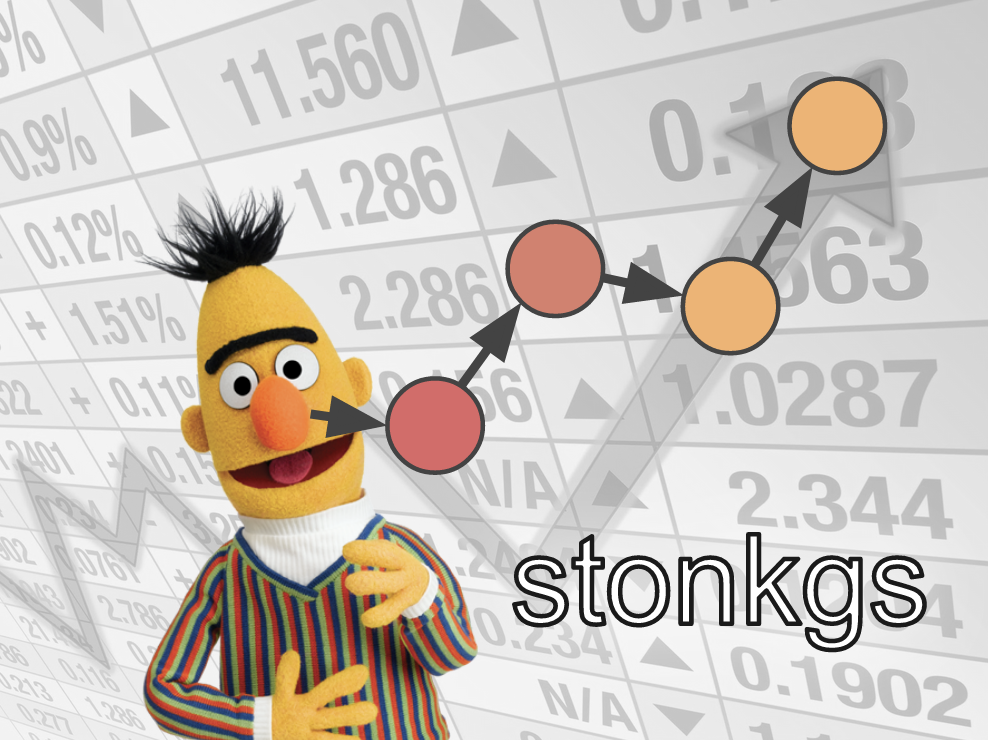用于生物医学文本和知识图谱数据的复杂Transformer
项目描述

STonKGs
STonKGs 是一个可以共同训练生物医学文本和知识图谱的高级 Transformer。这种多模态 Transformer 将来自 KG 的结构化信息与无结构化文本数据相结合,以学习联合表示。虽然我们在一个生物医学知识图谱(即来自 INDRA)上展示了 STonKGs,但该模型可以应用于其他领域。在以下各节中,我们将描述运行在任意给定数据集上训练模型的必要脚本。
💪 入门指南
数据格式
由于 STonKGs 在文本和 KG 数据上运行,因此预期相应数据文件包含两个模态的列。更具体地说,预期数据格式是 pandas dataframe(或用于预训练脚本的 pickled pandas dataframe),其中每行包含一个文本-三元组对。以下列是预期的
- source:给定文本-三元组对中的三元组源节点
- target:给定文本-三元组对中的三元组目标节点
- evidence:给定文本-三元组对中的文本
- (可选)class:在微调任务中给定文本-三元组对的类别标签(不适用于预训练过程)
请注意,源节点和目标节点都必须以生物表达语言(BEL)格式表示,更具体地说,它们需要包含在 INDRA KG 中。有关 BEL 格式的更多详细信息,请参阅例如 INDRA 的 BEL 处理器文档 和 PyBEL。
预训练 STonKGs
一旦您将 STonKGs 作为 Python 包安装(见下文),您可以通过运行以下命令开始对您的数据集进行 STonKGs 训练
$ python3 -m stonkgs.models.stonkgs_pretraining
可以通过修改 pretrain_stonkgs 方法中的参数轻松修改模型的配置。唯一需要更改的参数是 PRETRAINING_PREPROCESSED_POSITIVE_DF_PATH,它应指向您的数据集。
在 INDRA KG 上下载预训练的 STonKGs 模型
为了可能进行未来的适应,如在其他 KG 上进行进一步预训练,我们发布了在 INDRA KG 上预训练的 STonKGs 模型。STonKGs150k 和 STonKGs300k 都可以通过 Hugging Face 的模型库访问。
下载并初始化预训练的 STonKGs 模型最简单的方法是使用 from_default_pretrained() 类方法(默认为 STonKGs150k)
from stonkgs import STonKGsForPreTraining
# Download the model from the model hub and initialize it for pre-training
# using from_default_pretrained
stonkgs_pretraining = STonKGsForPreTraining.from_default_pretrained()
或者,由于我们的代码基于 Hugging Face 的 transformers 包,可以使用 .from_pretrained() 函数轻松下载和初始化预训练模型
from stonkgs import STonKGsForPreTraining
# Download the model from the model hub and initialize it for pre-training
# using from_pretrained
stonkgs_pretraining = STonKGsForPreTraining.from_pretrained(
'stonkgs/stonkgs-150k',
)
提取嵌入
预训练的 STonKGs 模型(或您自己的 STonKGs 变体)的学习嵌入可以通过两个简单的步骤提取。首先,需要使用 preprocess_file_for_embeddings 函数对包含文本-三元组的给定数据集(pandas DataFrame,见 数据格式)进行预处理。然后,可以使用预处理数据和 get_stonkgs_embeddings 函数获得学习嵌入
import pandas as pd
from stonkgs import get_stonkgs_embeddings, preprocess_df_for_embeddings
# Generate some example data
# Note that the evidence sentences are typically longer than in this example data
rows = [
[
"p(HGNC:1748 ! CDH1)",
"p(HGNC:2515 ! CTNND1)",
"Some example sentence about CDH1 and CTNND1.",
],
[
"p(HGNC:6871 ! MAPK1)",
"p(HGNC:6018 ! IL6)",
"Another example about some interaction between MAPK and IL6.",
],
[
"p(HGNC:3229 ! EGF)",
"p(HGNC:4066 ! GAB1)",
"One last example in which Gab1 and EGF are mentioned.",
],
]
example_df = pd.DataFrame(rows, columns=["source", "target", "evidence"])
# 1. Preprocess the text-triple data for embedding extraction
preprocessed_df_for_embeddings = preprocess_df_for_embeddings(example_df)
# 2. Extract the embeddings
embedding_df = get_stonkgs_embeddings(preprocessed_df_for_embeddings)
微调 STonKGs
在原始六个分类任务上微调 STonKGs 最直接的方法是运行微调脚本(请注意,此脚本假定您已指定 mlflow 日志记录器,例如使用 --logging_dir 参数)
$ python3 -m stonkgs.models.stonkgs_finetuning
此外,在您自己的代码中使用 STonKGs 进行您自己的微调任务(即序列分类任务)与初始化预训练模型一样简单
from stonkgs import STonKGsForSequenceClassification
# Download the model from the model hub and initialize it for fine-tuning
stonkgs_model_finetuning = STonKGsForSequenceClassification.from_default_pretrained(
num_labels=number_of_labels_in_your_task,
)
# Initialize a Trainer based on the training dataset
trainer = Trainer(
model=model,
args=some_previously_defined_training_args,
train_dataset=some_previously_defined_finetuning_data,
)
# Fine-tune the model to the moon
trainer.train()
使用 STonKGs 进行推理
您可以根据以下两种方式生成未见过的文本三元组对的新预测(只要节点包含在INDRA知识图谱中):1) 用于基准的微调模型;2) 您自己的微调模型。为了做到这一点,您首先需要加载/初始化微调模型。
from stonkgs.api import get_species_model, infer
model = get_species_model()
# Next, you want to use that model on your dataframe (consisting of at least source, target
# and evidence columns, see **Data Format**) to generate the class probabilities for each
# text-triple pair belonging to each of the specified classes in the respective fine-tuning task:
example_data = ...
# See Extracting Embeddings for the initialization of the example data
# This returns both the raw (transformers) PredictionOutput as well as the class probabilities
# for each text-triple pair
raw_results, probabilities = infer(model, example_data)
⬇️ 安装
可以从PyPI安装最新版本。
$ pip install stonkgs
可以直接从GitHub安装最新代码和数据。
$ pip install git+https://github.com/stonkgs/stonkgs.git
以开发模式安装,请使用以下命令
$ git clone git+https://github.com/stonkgs/stonkgs.git
$ cd stonkgs
$ pip install -e .
警告:由于stellargraph 目前不支持Python 3.9,此软件只能安装在Python 3.8上。
工件
预训练模型托管在HuggingFace。微调模型托管在STonKGs社区页面的Zenodo上,以及其他工件(node2vec嵌入、随机游走等)。
致谢
⚖️ 许可证
本软件包中的代码根据MIT许可证授权。
📖 引用
Balabin H.,Hoyt C.T.,Birkenbihl C.,Gyori B.M.,Bachman J.A.,Komdaullil A.T.,Plöger P.G.,Hofmann-Apitius M.,Domingo-Fernández D. STonKGs: A Sophisticated Transformer Trained on Biomedical Text and Knowledge Graphs (2021),bioRxiv,TODO。
🎁 支持
该项目得到了几个组织的支持(按字母顺序排列)
💰 资金
该项目得到了以下资助
| 资助机构 | 项目 | 拨款 |
|---|---|---|
| DARPA | 自动化科学知识提取(ASKE) | HR00111990009 |
🍪 Cookiecutter
本软件包使用@audreyfeldroy的cookiecutter软件包以及@cthoyt的cookiecutter-snekpack模板创建。
🛠️ 开发
README的最后一部分是如果您想通过代码贡献来参与其中。
❓ 测试
在克隆存储库并使用pip install tox安装tox后,可以重复运行tests/文件夹中的单元测试。
$ tox
此外,这些测试会随着每个提交在GitHub动作中自动重新运行。
📦 发布版本
在开发模式下安装软件包并使用pip install tox安装tox后,创建新版本的命令包含在tox.ini中的finish环境中。在shell中运行以下命令:
$ tox -e finish
此脚本执行以下操作:
- 使用BumpVersion将
setup.cfg和src/stonkgs/version.py中的版本号切换为不带-dev后缀。 - 将代码打包成tar存档和wheel格式。
- 使用
twine上传到PyPI。确保已经配置了.pypirc文件以避免在此步骤中需要手动输入。 - 推送到GitHub。您需要创建一个发布版本,与版本号升级的提交一起进行。
- 将版本升级到下一个补丁。如果您进行了重大更改并希望通过次要版本升级版本,可以在之后使用
tox -e bumpversion minor。
项目详情
下载文件
下载适合您平台的文件。如果您不确定该选择哪个,请了解更多关于安装包的信息。
源代码发行版
构建发行版
stonkgs-0.1.5.tar.gz的哈希值
| 算法 | 哈希摘要 | |
|---|---|---|
| SHA256 | 4275115969e561c4b393c478c982ae390404f730c97e3430fa853115ea6db1dd |
|
| MD5 | 06577eebd3212a5f7b5b295d25ef6767 |
|
| BLAKE2b-256 | eb2f1dd4ec83952a06443003e9913c38d235d0d84705f86899ba887d7b341f06 |
stonkgs-0.1.5-py3-none-any.whl的哈希值
| 算法 | 哈希摘要 | |
|---|---|---|
| SHA256 | 1ba747d3a6c13aeb0d14ed46bcbf4ac42e972dbb82bf99585409d625a933406f |
|
| MD5 | 06bfb3092720bd29ab8f931f329a9555 |
|
| BLAKE2b-256 | 569449ed709ca2c8aeb64a618fc668ffab41e987a67362f138d6a4187a66d2cf |












